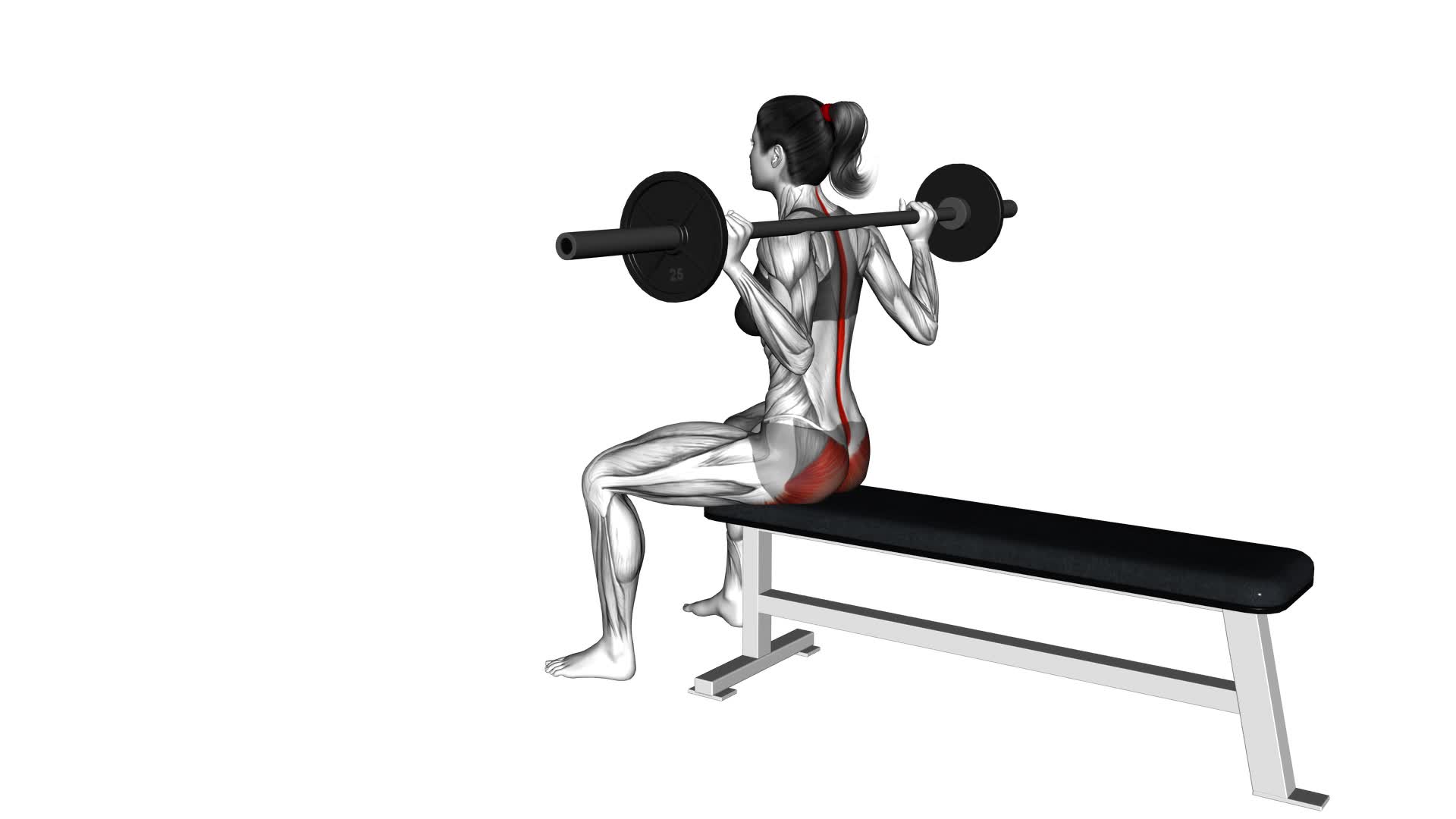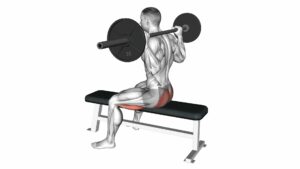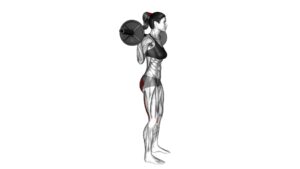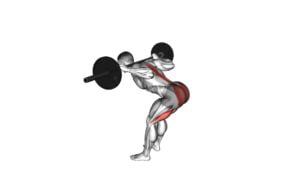Barbell Seated Good Morning (female) – Video Exercise Guide & Tips

Are you looking to strengthen your lower back and glutes? The barbell seated good morning is a fantastic exercise for targeting those muscle groups.
Watch This Exercise Video
In this video exercise guide, we'll show you the proper set-up, equipment, and step-by-step instructions for performing this exercise correctly.
We'll also share common mistakes to avoid and provide tips for progression and variation.
Get ready to take your fitness to the next level with the barbell seated good morning!
Key Takeaways
- Barbell Seated Good Morning improves core strength and engages various muscles including rectus abdominis, obliques, and lower back muscles.
- This exercise increases hamstring flexibility and stabilizes the spine, reducing the risk of lower back pain.
- Proper set-up and equipment include using a sturdy bench, positioning it for comfortable seating with feet flat on the floor, and resting the barbell on the upper back.
- Common mistakes to avoid during this exercise are rounding the back, using too much weight, and not engaging the core muscles. It is important to focus on form and gradually increase the weight for progression.
Benefits of the Barbell Seated Good Morning
The barbell seated good morning offers a wide range of benefits for women who incorporate it into their workout routine. This exercise is highly effective in improving core strength and increasing hamstring flexibility. When performed correctly, the barbell seated good morning engages the muscles in your core, including the rectus abdominis, obliques, and lower back muscles. This helps to stabilize the spine and improve overall core strength. Additionally, the movement involved in this exercise stretches the hamstrings, increasing their flexibility over time.
By incorporating the barbell seated good morning into your workout routine, you can significantly improve your core strength and hamstring flexibility. This is especially beneficial for women who participate in activities that require a strong core, such as running, dancing, or weightlifting. Strengthening your core can also help improve your posture and reduce the risk of lower back pain.
To perform the barbell seated good morning, start by sitting on a bench with a barbell resting on your upper back. Slowly hinge forward at the hips while keeping your back straight, until your torso is parallel to the ground. Return to the starting position by pushing through your heels and engaging your core.
Incorporating the barbell seated good morning into your workout routine can yield significant improvements in core strength and hamstring flexibility, making it an excellent exercise for women looking to enhance their overall fitness level.
Proper Set-Up and Equipment
To properly set up for the barbell seated good morning, you'll need a bench and a barbell. The bench should be sturdy and stable, with a flat and padded surface. Make sure the bench is positioned in a way that allows you to comfortably sit with your feet flat on the floor.
Place the barbell across your upper back, resting it on your trapezius muscles. Your hands should be slightly wider than shoulder-width apart, gripping the barbell securely. Adjust your grip and positioning as needed to find a comfortable and stable position.
If you need to modify the barbell seated good morning, there are a few options available. If you don't have access to a barbell, you can use dumbbells or kettlebells as an alternative. Simply hold the weights in each hand, with your arms extended and palms facing inward. Perform the exercise in the same manner, focusing on maintaining proper form and control throughout the movement.
Additionally, if you don't have access to a bench, you can perform the exercise on the floor. Sit with your legs extended in front of you, and place the barbell or weights across your upper back as described earlier. This modification allows you to still engage the same muscle groups while seated on the floor.
Step-by-Step Guide to Performing the Exercise
Now, let's dive into the step-by-step guide for performing the barbell seated good morning exercise. Follow these instructions to ensure proper form and maximize muscle activation:
- Start by sitting on a bench with your feet shoulder-width apart and a barbell resting on your upper back. Make sure your back is straight and your core is engaged.
- Slowly lean forward from the hips while keeping your back straight. Lower your torso until it's parallel to the floor, feeling a stretch in your hamstrings.
- Pause briefly at the bottom of the movement, then slowly return to the starting position by pushing through your heels and engaging your glutes.
- Repeat the movement for the desired number of reps, focusing on maintaining proper form and control throughout.
To progress this exercise and challenge your muscles even more, you can increase the weight of the barbell, perform more reps, or add resistance bands for added resistance. Remember to start with a weight that allows you to maintain proper form and gradually increase the intensity as you become stronger.
Common Mistakes to Avoid
To avoid common mistakes, make sure you use proper form and engage your muscles throughout the barbell seated good morning exercise. This exercise can be highly effective for targeting your lower back and glutes, but it's important to perform it correctly to avoid injury and maximize results.
One common mistake is rounding your back during the movement. This not only puts excessive strain on your spine but also takes away from the targeted muscles. To prevent this, keep your back straight throughout the exercise and focus on hinging at your hips.
Another mistake to avoid is using too much weight. Starting with a lighter weight allows you to focus on your form and gradually increase the load as you become more comfortable and confident.
Additionally, make sure to engage your core muscles and keep your abdominals tight throughout the exercise. This helps stabilize your body and protect your lower back.
Tips for Progression and Variation
Explore different ways to progress and vary your barbell seated good morning exercise for continued challenge and muscle growth. Here are four tips to help you maximize your progress and keep your workouts interesting:
- Increase the weight: Gradually increase the weight on the barbell to continually challenge your muscles. Start with a weight that allows you to perform the exercise with proper form, and then gradually add more weight as you get stronger.
- Adjust the rep range: Vary the number of repetitions you perform during each set. For example, you can start with higher reps (10-12) to build endurance, then progress to lower reps (6-8) to focus on strength and muscle growth.
- Modify the tempo: Change the speed at which you perform the exercise. Slow down the eccentric (lowering) phase to increase time under tension and stimulate muscle growth. Alternatively, try explosive repetitions to improve power and explosiveness.
- Incorporate different variations: Experiment with different variations of the barbell seated good morning exercise to target different muscle groups and keep your workouts fresh. For example, you can try using a wider or narrower grip, changing the angle of your back, or performing the exercise with dumbbells instead of a barbell.
Frequently Asked Questions
How Many Sets and Reps Should I Do for the Barbell Seated Good Morning Exercise?
To progress in the barbell seated good morning exercise, it's important to determine the right number of sets and reps.
Start by focusing on your form and technique to avoid common mistakes.
Once you feel comfortable, aim for 3-4 sets of 8-12 reps, using a weight that challenges you but allows for proper execution.
Remember to listen to your body and gradually increase the intensity over time for continued progress.
Can I Perform the Barbell Seated Good Morning Exercise Without Using a Barbell?
Yes, you can perform alternative exercises to the barbell seated good morning without using a barbell. However, it's important to note that using a barbell has specific benefits. It helps to increase the resistance and intensity of the exercise, targeting your posterior chain muscles more effectively.
Alternatives like dumbbell or kettlebell variations can still be effective, but may not provide the same level of resistance. It's best to consult with a fitness professional to determine the most suitable alternative for your goals and abilities.
Is the Barbell Seated Good Morning Exercise Suitable for Beginners?
The barbell seated good morning exercise is a great choice for beginners. It offers numerous benefits for women, such as strengthening the lower back, hamstrings, and glutes.
However, it's important to avoid common mistakes while performing this exercise, such as rounding the back or using too heavy of a weight. By starting with lighter weights and focusing on proper form, you can gradually build strength and avoid injury.
Should I Feel Any Specific Muscles Working During the Barbell Seated Good Morning Exercise?
During the barbell seated good morning exercise, you should feel specific muscles working. This exercise primarily targets your hamstrings, glutes, and lower back muscles.
To ensure proper muscle activation, focus on maintaining good form and technique. Keep your back straight, hinge at the hips, and lower the barbell down as far as you can comfortably go without rounding your back. Engage your core throughout the movement to provide stability and prevent any unnecessary strain on your lower back.
Can I Include the Barbell Seated Good Morning Exercise in My Leg Day Workout Routine?
Yes, you can definitely include the barbell seated good morning exercise in your leg day workout routine.
This exercise offers numerous benefits, such as strengthening your glutes, hamstrings, and lower back. It also helps improve your posture and stability.
There are variations of this exercise that you can try, like using different grip positions or adding resistance bands.
Remember to start with lighter weights and gradually increase as you become more comfortable and stronger.
Conclusion
In conclusion, the barbell seated good morning is a highly effective exercise for targeting the lower back, glutes, and hamstrings.
With proper set-up and equipment, and following the step-by-step guide, you can perform this exercise safely and efficiently.
Avoiding common mistakes and incorporating progression and variation will help you maximize the benefits and continue to challenge your muscles.
So, give the barbell seated good morning a try and take your lower body strength and stability to the next level.

Author
Years ago, the spark of my life’s passion ignited in my mind the moment I stepped into the local gym for the first time. The inaugural bead of perspiration, the initial endeavor, the very first surge of endorphins, and a sense of pride that washed over me post-workout marked the beginning of my deep-seated interest in strength sports, fitness, and sports nutrition. This very curiosity blossomed rapidly into a profound fascination, propelling me to earn a Master’s degree in Physical Education from the Academy of Physical Education in Krakow, followed by a Sports Manager diploma from the Jagiellonian University. My journey of growth led me to gain more specialized qualifications, such as being a certified personal trainer with a focus on sports dietetics, a lifeguard, and an instructor for wellness and corrective gymnastics. Theoretical knowledge paired seamlessly with practical experience, reinforcing my belief that the transformation of individuals under my guidance was also a reflection of my personal growth. This belief holds true even today. Each day, I strive to push the boundaries and explore new realms. These realms gently elevate me to greater heights. The unique combination of passion for my field and the continuous quest for growth fuels my drive to break new ground.







